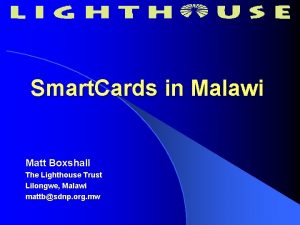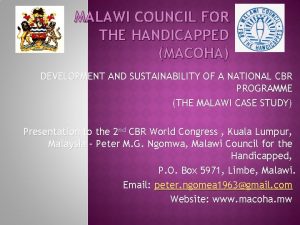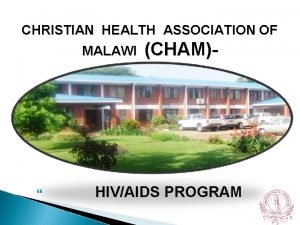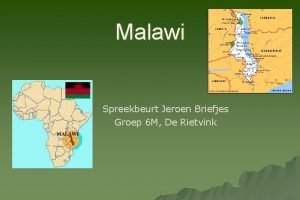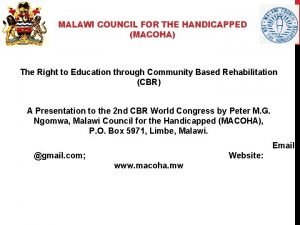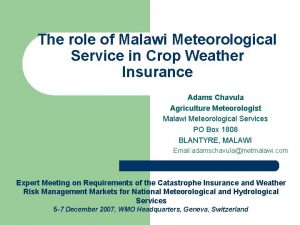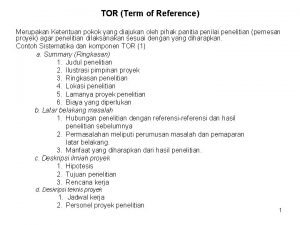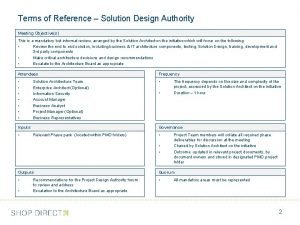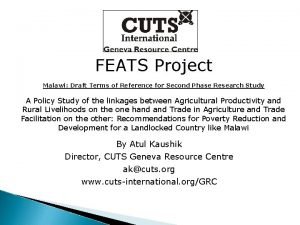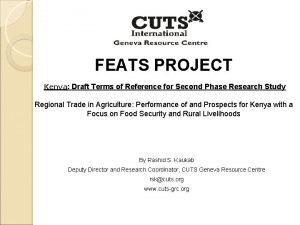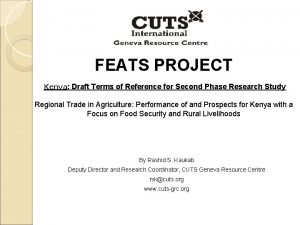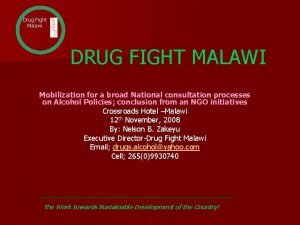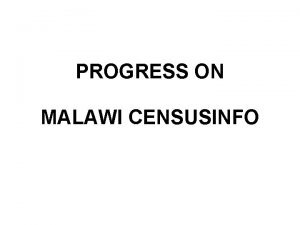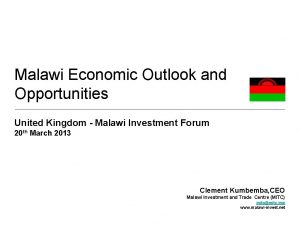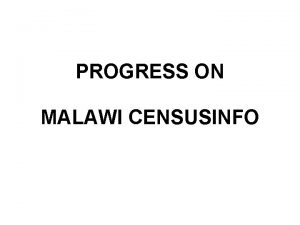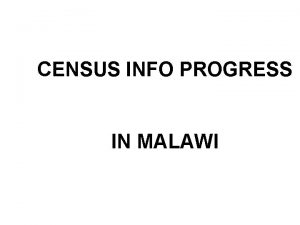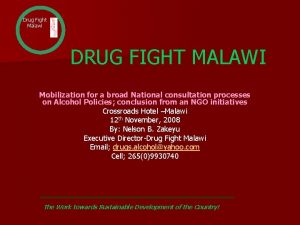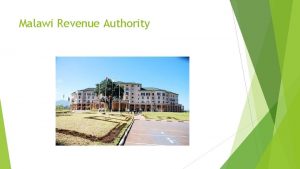FEATS Project Malawi Terms of Reference for Second



















- Slides: 19

FEATS Project Malawi: Terms of Reference for Second Phase Research Study A Policy Study of the linkages between Agricultural Productivity and Rural Livelihoods on the one hand Trade in Agriculture and Trade Facilitation on the other: Recommendations for Poverty Reduction and Development for a Landlocked Country like Malawi By Lawrence Mapemba University of Malawi Bunda College 1 st October, 2009 CUTS GRC, GENEVA

Background Malawi agro-based economy with 85 percent of the population depending on agriculture The agricultural sector generates more than 90 percent of the export earnings to the economy and contributes 40% of the GDP The sector employs a large proportion of population Dominated by smallholder subsector – contributes 75% of food crop production in the country Lack of investment and development resulted inability to attain its potential in trade performance International trade can foster economic development and reduce poverty through employment There is need for coherence between trade and development policies

Study Objectives Collect information and analyze recent trends in agricultural productivity, agricultural trade, livelihoods, and trade facilitation measures particularly in the context of landlocked status of Malawi Examine the key linkages and relationships between these three aspects using a holistic framework Generate new insights and knowledge that carry practical implications including possible development of concrete projects to contribute to the finding of solutions through a coherent policy framework that will assist Malawi in meeting the objectives of Vision 2020

Key Substantive Issues to be covered Performance, role and constraints faced by the agricultural sector with focus on rural livelihoods, productivity, and trade Trade facilitation needs and measures with a focus on those directly related to Malawi as a landlocked country Linkages and relationships among agricultural productivity, trade and livelihoods with focus on identifying areas of synergy

Key Substantive Issues to be covered Policy frameworks related to agriculture, trade, and trade facilitation Development of coherent recommendations in the areas under study to advance poverty reduction and development objectives

Methodology Review of literature Stakeholder consultations and meetings Sample survey

Sample Surveys and Stakeholder Meetings The data collected through literature review, meetings with stakeholders, and by accessing existing data sources will be complemented with selected field studies/sample surveys where absolutely needed Meetings will be done with the following public, private and NGO stakeholders: Ministry of Trade, Industry and Private Sector Development; Ministry of Agriculture and Food Security; Ministry of Finance; Ministry of Development Planning and Cooperation, Food Early Warning System Network (FEWS NET), Malawi Chamber of Commerce and Industry, Malawi Export Promotion Council, National Smallholder Farmers Association, Tobacco Exporter Association, Mulli Brothers, Trans Globe, Rab Processors Company Limited, Grain Traders Association, Malawi Economic Justice Network, and Civil Society Agriculture Network.

Detailed To. R of the Study Introduction Trends in crop production, agric exports and imports, employment in agric, rural poverty and land tenure (last ten years) Trends in agric productivity – crops and livestock Landlocked and trade facilitation issues – main constraints Policy framework – agricultural development, trade facilitation policies and their linkages

Agricultural productivity, trade and livelihoods What is the relationship between agricultural productivity and agriculture trade performance? ◦ Comparison between crop productivity and trade ◦ Effect of increased productivity of tradable crops and livestock on trade performance (surplus) ◦ Role of agricultural policies influencing productivity and trade performance in crops and livestock ◦ Linkages among agricultural/livestock policies, productivity, and imports of livestock products

Agricultural productivity, trade and livelihoods cont’d What is the relationship between agricultural trade performance and rural livelihoods? ◦ Livelihoods is defined as access and availability of food at household level as well as increased rural household income and sources of incomes ◦ The study will investigate if increased productivity has resulted in improvements of household food security through improved incomes ◦ Linkages between increased production of traderelated crops and household income-estimate subsistence farmers ◦ Informal cross-border trade and rural livelihoods

Landlockedness, trade facilitation, and trade in agriculture What are the main constraints for trade in agriculture in Malawi resulting from being landlocked? ◦ Issues to be studied include: costs of transportation; delayed delivery of goods; and goods lost during haulage ◦ Available trade corridors and their advantages and disadvantages (tariff and non-tariff barriers) ◦ Effects of landlockedness on production decisions on tradable crops and livestock products

Landlockedness, trade facilitation, and trade in agriculture cont’d What are the past, present, and planned trade facilitation measures that attempt to address the identified constraints? ◦ Efforts achieved through value-addition or processing before exports to increase the shelf life of agricultural products ◦ The study will look into any processing done to fish, meats, vegetables and milk prior to exporting ◦ Major trading partners for such products

Landlockedness, trade facilitation, and trade in agriculture cont’d What are the main corridor schemes and how do they address the identified constraints? ◦ The study will assess efforts on trade facilitation which aim at promoting trade development of trade corridors; trade protocols and trade agreements relating to various corridor schemes.

National, regional and international policy dimensions, and the role of stakeholders What are the key features of national policies related to agriculture, trade and trade facilitation? ◦ Study national policies related to agriculture, trade and trade facilitation Link with government’s goal of transforming the country from a predominantly importing and consuming nation to a predominantly producing and exporting nation (MGDS) ◦ Progress in implementation of the policies and strategies as well as successes and failures or challenges

National, regional and international policy dimensions, and the role of stakeholders What is the impact of regional (e. g. , SADC and COMESA) and international (under the WTO) rights and obligations on national policies on trade, agriculture and trade facilitation? ◦ The study will identify the relevant parts of SADC, COMESA and the WTO that can either hinder or facilitate national policy making on agriculture, trade, and trade facilitation

National, regional and international policy dimensions, and the role of stakeholders Who are the main domestic stakeholders? What is the level of their respective capacities and involvement in relevant policy making and implementation? ◦ Stakeholders that will be involved in this study will include relevant government ministries and departments, civil society involved in trade, Tobacco Association of Malawi, Private Traders, Farmers Associations e. g. Farmer Union of Malawi and National Association of Smallholder Farmers

Synthesis of linkages This will involve data analysis and summarizing issues out of all information obtained through consultations, meetings and literature review ◦ Linkages on various aspects of agricultural productivity – trade performance – livelihoods

Recommendations The study findings will provide detailed recommendations for different stakeholders. These include the following: ◦ ◦ government development partners CSOs, particularly farmers organizations private sector and business organizations

Questions?
 Lighthouse malawi
Lighthouse malawi Mary's meals malawi
Mary's meals malawi Malawi council for the handicapped
Malawi council for the handicapped Malawi'''s pizza delivery
Malawi'''s pizza delivery Christian health association of malawi
Christian health association of malawi Welke taal spreken ze in malawi
Welke taal spreken ze in malawi Macoha malawi
Macoha malawi Meteorological services for insurance
Meteorological services for insurance Mij fm radio frequency
Mij fm radio frequency Ethiopian social accountability program 3
Ethiopian social accountability program 3 186 282 miles per second into meters per second
186 282 miles per second into meters per second Like terms and unlike terms in polynomials
Like terms and unlike terms in polynomials Combining like terms practice
Combining like terms practice Term of reference (tor) 1972
Term of reference (tor) 1972 Technical design authority terms of reference
Technical design authority terms of reference Term of reference (tor)
Term of reference (tor) Terms of reference in a report
Terms of reference in a report Reference node and non reference node
Reference node and non reference node Reference node and non reference node
Reference node and non reference node Fspos vägledning för kontinuitetshantering
Fspos vägledning för kontinuitetshantering
